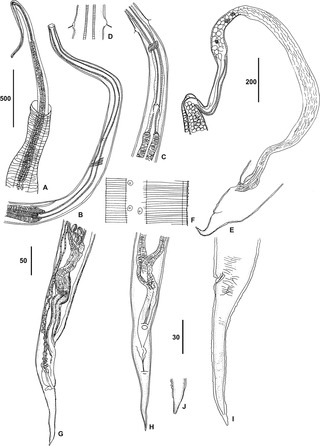Northern root-knot nematode is a species of vegetable pathogens which produces tiny galls on around 550 crop and weed species. They invade root tissue after birth. Females are able to lay up to 1,000 eggs at a time in a large egg mass. By surviving harsh winters, they can survive in cold climates.

Enoplea (enopleans) is a class, which with the classes Secernentea and Chromadorea make up the phylum Nematoda in current taxonomy. The Enoplea are considered to be a more ancestral group than the Chromadorea, and researchers have referred to its members as the "ancestrally diverged nematodes", compared to the "more recently diverged nematodes" of Chromadorea.

The Chromadorea are a class of the roundworm phylum, Nematoda. They contain a single subclass (Chromadoria) and several orders. With such a redundant arrangement, the Chromadoria are liable to be divided if the orders are found to form several clades, or abandoned if they are found to constitute a single radiation.

Pratylenchus penetrans is a species of nematode in the genus Pratylenchus, the lesion nematodes. It occurs in temperate regions worldwide, regions between the subtropics and the polar circles. It is an animal that inhabits the roots of a wide variety of plants and results in necrotic lesions on the roots. Symptoms of P. penetrans make it hard to distinguish from other plant pathogens; only an assay of soil can conclusively diagnose a nematode problem in the field. P. penetrans is physically very similar to other nematode species, but is characterized by its highly distinctive mouthpiece. P. penetrans uses its highly modified mouth organs to rupture the outer surface of subterranean plant root structures. It will then enter into the root interior and feed on the plant tissue inside. P. penetrans is considered to be a crop parasite and farmers will often treat their soil with various pesticides in an attempt to eliminate the damage caused by an infestation. In doing this, farmers will also eliminate many of the beneficial soil fauna, which will lead to an overall degradation of soil quality in the future. Alternative, more environmentally sustainable methods to control P. penetrans populations may be possible in certain regions.
Pratylenchus vulnus is a species of plant pathogenic nematode best known for infecting Persian walnut. It is also known to infest potatoes, apricots, peaches and nectarines, holiday cacti, grape and citruses.

Helicotylenchus dihystera is a plant pathogenic nematode. It is known to inhabit sugarcane, rice, potatoes, corn, peanut, millet, sorghum, banana and forest trees.
Subanguina radicicola, the grass root-gall nematode, is a plant pathogenic nematode.

Anguina agrostis is a plant pathogenic nematode.

Nematology is the scientific discipline concerned with the study of nematodes, or roundworms. Although nematological investigation dates back to the days of Aristotle or even earlier, nematology as an independent discipline has its recognizable beginnings in the mid to late 19th century.

Diplogasterida was an order of nematodes. It was sometimes placed in a monotypic subclass Diplogasteria, but molecular phylogenetic evidence has shown it to be embedded in the family Rhabditidae. The confusion of having a hierarchical nesting of groups that were formerly mutually exclusive has led to a profusion of names. Although completely revised taxonomy of nematodes that builds on recent classification systems as well as recent phylogenetic evidence is still necessary, most contemporary taxonomic studies now treat all groups listed under "Diplogasterina" below as a single family, Diplogastridae.

The nematodes, roundworms or eelworms constitute the phylum Nematoda. They are a diverse animal phylum inhabiting a broad range of environments. Most species are free-living, feeding on microorganisms, but there are many that are parasitic. The parasitic worms (helminths) are the cause of soil-transmitted helminthiases.

Thelazioidea is a superfamily of spirurian nematodes in the large order Spirurida. Like all nematodes, they have neither a circulatory nor a respiratory system.

A nematode infection is a type of helminthiasis caused by organisms in the nematode phylum.
Spiruroidea is a superfamily of Spirurida.
Legerella is a genus of parasitic alveolates of the phylum Apicomplexa. Species in this genus that usually infect the malpighian tubules of invertebrates.
Enoplida is an order of nematodes. It is one of two orders in Enoplia, which is one of two subclasses in Class Enoplea.
The Enoplia are a subclass of nematodes in the class Enoplea.

Root-gall nematodes are plant-parasitic nematodes from the genus Subanguina that affect grasses, including cereals, and some other plants, such as mugwort. They are distinct from the Root-knot nematodes which are from the genus Meloidogyne. So far around twenty-five separate species of Subanguina have been identified, although the most well-known and type species is Subanguina radicicola.
Microbivory is a feeding behavior consisting of eating microbes practiced by animals of the mesofauna, microfauna and meiofauna.









